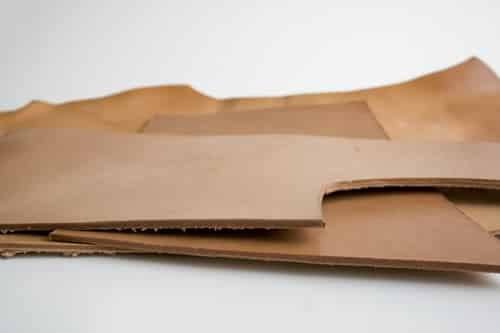Vegetable-Tanned Leather
Vegetable-tanned leather, often referred to as "veg-tanned" leather, is tanned using tannins found in plant matter, such as tree bark, leaves, and even some fruits.
Varieties of Vegetable-Tanned Leather Based on Its Physical Characteristics

This method of tanning has been used for centuries and is known for producing leather with a firm texture that can be easily tooled and molded. This type of leather for shoemaking is environmentally friendly and develops a rich patina.
Although "veg-tanned" generally refers to the tanning process, there are distinct varieties influenced by several physical characteristics:
Thickness of Vegetable-Tanned Leather
Veg-tanned leather varies in thickness, suitable for products ranging from thin wallets or bookbinding to thicker items like belts, saddles, soles, or armor.
Finish of Vegetable-Tanned Leather
Natural: Remains undyed, allowing the leather to maintain its natural hue. Over time, it darkens and develops a unique patina.
Dyed: Available in a wide array of colors.
Waxed or Oiled: Certain veg-tanned leathers undergo treatments with oils or waxes to enhance suppleness or achieve a specific finish.
Tooling and Molding Vegetable-Tanned Leather
A hallmark of veg-tanned leather is its capacity to hold tooling (embossed designs) and molded shapes, especially when wet.
Source and Origin
The region or tannery can influence the leather's texture, color, and overall quality. For instance, Italian veg-tanned leather, often deemed premium, possesses unique characteristics.
Usage of vegatable-tanned leather
Bridle Leather: A double-finished type of veg-tanned leather, predominantly used for horse bridles and high-end belts.
Harness Leather: Resembles bridle leather in characteristics but is thicker, making it ideal for harnesses and straps.
Russet Leather: Represents veg-tanned leather in its raw form, perfect for dyeing, tooling, or adding finishes like we do in "Sneakers Making Course" where created a patina on upper leather to upgrade the look of the sneakers.
Common Uses in Shoemaking: This leather finds applications in artisanal footwear, sandals, leather insoles like we do in Bespoke Derby Course, soles, and stiffeners.
Using Vegetable Tanned Leather for Various Shoe Parts
Vegetable-tanned leather is derived from a variety of animal hides, each possessing unique thickness attributes. These differences dictate their specific uses in shoemaking.
For insoles/stiffeners:
Opt for the shoulder section, which typically measures 2-3 mm in thickness.
For instance, we utilize this type of vegetable-tanned leather in my Unisex Sandal Course to create an elegant and modest insole and outsole by showcasing the natural appearance of this leather kind.
And here's an example of how to create gorgeous leather insoles for sandals with simple tools in this shoemaking article:"How to cut leather insoles for sandals using simple tools".
For uppers:
Employ veg-tanned leather from any animal hide, ideally ranging between 0.8-1.1 mm in thickness.
Choosing Veg-Tanned Leather for Soles:
For soles: use sole bends from the spine (4-5 mm thickness). Suitable for leather stacked heels.
-Use the back of the animal, known as sole bends.
-Best quality is oak bark tanned bends.
-Look for smooth surfaces on both grain and flesh sides, even color, and flexibility.
-Avoid leather with stretch marks, indicating it's not from the back of the hide.
-If it still has some marks , remember that you can dye it and polish to hide marks.
I personally enjoy crafting shoe soles from vegetable-tanned leather, and I teach students in various shoemaking courses on how to create a variety of shoe soles using different finishing techniques while utilizing basic shoemaking tools:
Flat Ballet Shoes with a colorful sole
Fashionable Flat Ballet Shoes from Fabric Course featuring a smooth and velvety black outline,
Oxford shoes Course featuring a shoe sole that merges into a wedge heel,
In my Moccasin-making course, I instruct students on how to create double soles.
Loafers Making Course using pre-made welt is a great way for beginners to get started.
Customized Derby shoes Course with an opanka sole that is hand-sewn
High heels made of veg-tanned leather with a personalized sole design for a Pump Shoes course
many more diverse courses that utilize vegetable-tanned leather in a variety of shoemaking techniques.
Here's a quick overview of the various sole finishing techniques when utilizing vegetable-tanned leather for outsoles: "Best shoe sole making techniques[from beginners to pro]", "How to finish shoe sole [Shoemaking Tutorial]".
While veg-tanned leather is adaptable and has distinctive qualities, it is also less resistant to water damage and UV rays than chrome-tanned leather. It needs to be well cared for to keep its durability and attractiveness.
Online stores to buy Veg-Tanned leather
Here are some online stores where you can purchase various vegetable-tanned leather types:
https://waterhouseleather.com/?s=full+grain+leather
https://tandyleather.com/collections/veg-tan
https://www.zackwhite.com/vegetable-tanned-tooling-sides
https://www.springfieldleather.com/shop-now/leather/veg-tan
https://buyleatheronline.com/en/19-vegetable-tanned-leather
https://www.aacrack.com/collections/vegetable-tanned-leather?page=2
https://www.aacrack.com/search?q=sole+bend&options%5Bprefix%5D=last
.
